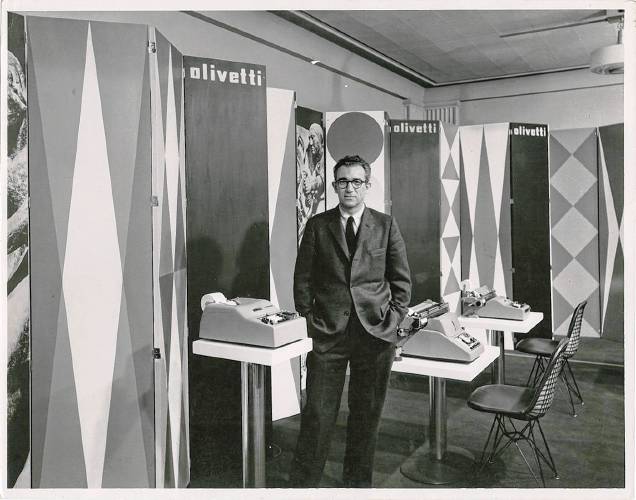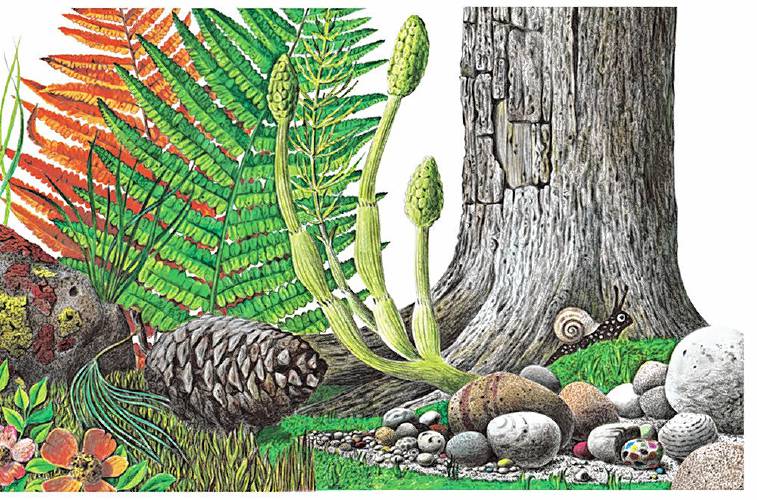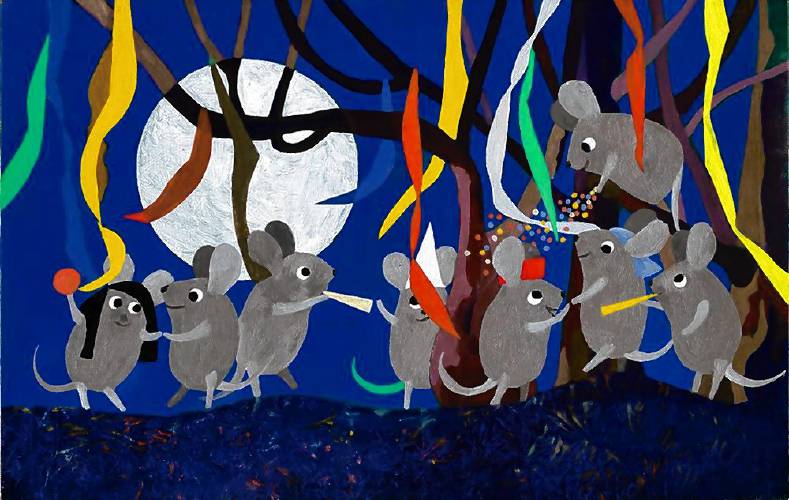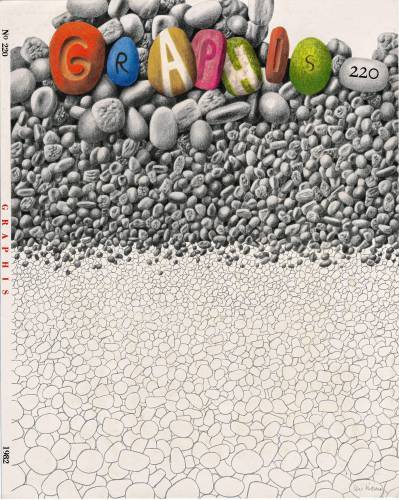The infinite imaginarium of Leo Lionni: A groundbreaking Rockwell exhibit
| Published: 12-29-2023 6:05 PM |
As an inquisitive boy growing up in Amsterdam, he kept a menagerie of snails and toads and other small woodland fauna in his room, populating the glass terrariums he’d filled with mosses and ferns. Influenced by one uncle, an architect, and two others who were art collectors, the youth spent hours in museums sketching the classical paintings. Just outside his bedroom hung an original Marc Chagall and his parent’s home was filled with serious paintings his uncles stored there. As an adult he was a Modernist and would revolutionize graphic design and advertising while later creating more than 40 children’s books. Yet Leo Lionni (1910 – 1999) never received any formal art training.
“Leo was deeply in love with the natural world and … he had this arsenal of communication skills,” Leonard Marcus said during the Norman Rockwell Museum’s opening night of the first major American retrospective of the Dutchman’s work. The children’s book historian shared in a discussion with the artist’s granddaughter Annie Lionni and Steven Heller, a design historian. The three-gallery Stockbridge exhibit, continues through May 27 and is complemented by a full-color catalogue, “Leo Lionni: Storyteller, Artist, Designer” (184 pages, Abbeville Press, $40).
Lionni’s father was a roving oil company accountant and his mother, an opera singer. When the artist was 12, his parents moved to the United States and for a period he attended school in Philadelphia. By his early teens his father had been reassigned to Genoa, Italy, a country that would enrapture Leo.
“He loved the sense of Italy,” Ms. Lionni said. “He loved the sounds and the flavor.” In his later years he moved to Tuscany where, annually for almost 40 years, he created children’s books.
Since his childhood he’d wanted to become an artist and originally set out to be a serious painter. His father had little confidence in such a career. As an appeasement, Lionni achieved a degree in economics from the University of Genoa.
“His Dad wanted him in business,” Ms. Lionni said. “I think the way that he solved that problem was by going into advertising.”
By his late teens he was creating graphic designs for Campari liqueurs and other commercial entities.
At age 21 he married Nora Maffi, quite incidentally the daughter of one of the founders of the Italian Communist Party. They had two sons and remained married for 68 years.
Article continues after...
Yesterday's Most Read Articles
 Greenfield homicide victim to be memorialized in Pittsfield
Greenfield homicide victim to be memorialized in Pittsfield
 1989 homicide victim found in Warwick ID’d through genetic testing, but some mysteries remain
1989 homicide victim found in Warwick ID’d through genetic testing, but some mysteries remain
 As I See It: Between Israel and Palestine: Which side should we be on, and why?
As I See It: Between Israel and Palestine: Which side should we be on, and why?
 Softball: Greenfield puts up 9-spot in the 8th inning to knock off rival Turners 11-2 in extra-inning thriller (PHOTOS)
Softball: Greenfield puts up 9-spot in the 8th inning to knock off rival Turners 11-2 in extra-inning thriller (PHOTOS)
 DA to announce breakthrough in 1989 unsolved homicide in Warwick
DA to announce breakthrough in 1989 unsolved homicide in Warwick
 Former Greenfield man granted new trial after 1995 murder conviction, walks free
Former Greenfield man granted new trial after 1995 murder conviction, walks free
Lionni had no interest in communism and was fervently anti-fascist. In 1938, the Mussolini regime instituted draconian measures upon the country’s Jewry and the family left for America a year later. From all this relocation Lionni became a polyglot, speaking five languages fluently.
They settled in Philadelphia and Lionni secured design work with N.W. Ayer, the country’s third largest advertising firm. His rise was meteoric and soon he was company’s art director, creating images for accounts ranging from Ford cars to the Container Corporation of America, purveyors of the latest fashions in cardboard boxes. Lionni met the challenge of making potentially boring ads vivid by bringing in the big guns. He commissioned such luminaries as the sculptor Henry Moore and the artist Alexander Calder for design work. Years before his obsession with Campbell’s Soup cans and painting his hair silver, Lionni gave work to a fledgling Andy Warhol in designing shoe ads. The Dutchman also provided the expatriate German Eric Carle with his first job upon his arrival to the U.S.
“He also introduced something often left out of graphic design at the time,” Heller said, “and that was humor. He had a great wit.”
A simple, three panel cartoon for Nicholson File Co. shows a male museum attendee puzzled by an abstract Cubist female torso. Using a file tool he whittles the statue into a more pleasing feminine form. A 1940s ad for Comptometer calculators displays a stork delivering sextuplets to a soldier, passed out cold. You only see the legs and boots of the unconscious G.I. The copy notes that this lucky doughboy will receive an additional $180 monthly, “money in the bank.”
During these years the artist also created patriotic posters for the armed forces as well as a long running campaign, “Never Underestimate The Power of a Woman” for “Ladies’ Home Journal.”
“He had a sense of whimsy, but also an appreciation of abstraction, not everything had to be representational,” Heller said.
The design historian noted, prior to Lionni and the Modernists, the prevailing zeitgeist in advertising was to be realistic, romantic and sentimental.
“Rockwell was one of the leaders in that,” Heller quipped, “but I’m not going to criticize it, because he did it so well.”
The Modernists broke down images to absolute minimalism, avoiding the visual static of extraneous detail.
There was a restlessness to Lionni. By 1947 he was running his own design firm in New York, fleeing from the rigid corporate styles and the “smug, professional look” of Ford automobile propaganda.
Lionni’s imaginative vision was inescapable and culturally influential. He designed the first cover for “Sports Illustrated,” as well as the classical paperback illustrations for many stories including Albert Camus’ “The Stranger” and “The Myth of Sisyphus.”
For 12 years he was art editor for “Fortune” magazine, which Heller described as “a monument to capitalism.” He rocked what had been a fairly stodgy monthly into a fireworks of wild, imaginative illustration and covers ranging from the cartoonish to geometrical abstractions.
In 1955, when the photographer Edward Steichen mounted the comprehensive photographic study “The Family of Man,” at New York’s Museum of Modern Art, Lionni designed the catalogue. Still in print, at last count more than four million copies have been sold.
Three years later he designed the American pavilion at Brussels World’s Fair and titled the entry “Unfinished Business.” Visitors would enter a tunnel to be met with depictions of our country’s problems, past and present, from urban blight to race relations. A large photograph of children of various races playing together in a meadow of flowers suggested a much rosier future.
“Which basically made segregationist politicians from the South’s heads explode when they found out about it,” one writer noted. A congressional investigation was threatened and the exhibit was shut down.
By chance Lionni entered into creating children’s books. To entertain his young grandchildren — Ms. Lionni and her brother — during a train ride, he tore colored bits of paper from a magazine. He conjured up the story of what became “Little Blue and Little Yellow,” which not only entertained the two children but many of the commuters as well.
In 1959, the simple tale became a best-selling book and Lionni went on to receive four Caldecott honors during this career.
Ms. Lionni noted that her grandfather strived to compartmentalize his several pursuits. “He felt that (art) galleries wouldn’t take him seriously if they knew he was doing books for children,” she said.
At age 50 the artist moved to Tuscany.
“Everyone thought I was crazy because I had very little money, but it was what I needed to do,” he recalled in his autobiography “Between Worlds.”
He created the book “Frederick” about a poetic, if lazy, field mouse who shares his gifts of insight with his family. In “Swimmy,” a lone, tiny fish learns that to survive in the seas it’s best to have friends and lots of them. “Cornelius” is a talented alligator who can walk upright, allowing him to see further than any of his other reptilian friends. Deceptively simple and brief in text, each story has a moral.
The artist’s books are fluid with color, frequently illustrated with watercolor, collage and homemade stamps.
“He experimented in style and the different ways of telling stories,” Marcus said. “He was a fabulist and it seems, without exaggeration, that he was the Aesop of our time.”
The children’s book historian said that of Lionni’s many achievements one was “to slow time down for children … and have them look more closely at the most ordinary things in their environment.”
Since his boyhood the artist was intrigued by the age, shape and color of rocks and pebbles. When he illustrated such landscapes, including a book solely devoted to pebbles, the draftsmanship was exquisite.
As he approached the age of 60 he entered into an otherworldly surrealism, intricately drawing imaginary plants and trees. These studies became the 1977 book “Parallel Botany” and he cast many of these fanciful creations in bronze. If anyone could sum up the complexities of the artist, it was his granddaughter.
“He had the mind of an American,” Ms. Lionni said. “The heart of a Dutchman and the soul of an Italian.”
“Between Worlds: The Art and Design of Leo Lionni,” continues through May 27 at the Norman Rockwell Museum. Open Monday through Friday, 10 a.m. to 4 p.m., weekends 10 a.m. to 5 p.m. Admission: Adults $20; students with ID $10; ages 18 and under, free. Closed New Year’s Day.





 Speaking of Nature: Indulging in eye candy: Finally, after such a long wait, it’s beginning to look like spring is here
Speaking of Nature: Indulging in eye candy: Finally, after such a long wait, it’s beginning to look like spring is here Celebrating ‘Seasonings’: New book by veteran preacher and poet, Allen ‘Mick’ Comstock
Celebrating ‘Seasonings’: New book by veteran preacher and poet, Allen ‘Mick’ Comstock Faith Matters: How to still the muddy waters of overthinking: Clarity, peace and God can be found in the quiet spaces
Faith Matters: How to still the muddy waters of overthinking: Clarity, peace and God can be found in the quiet spaces A time for every purpose under heaven: Free sing-a-long Pete Seeger Fest returns to Ashfield, April 6
A time for every purpose under heaven: Free sing-a-long Pete Seeger Fest returns to Ashfield, April 6
